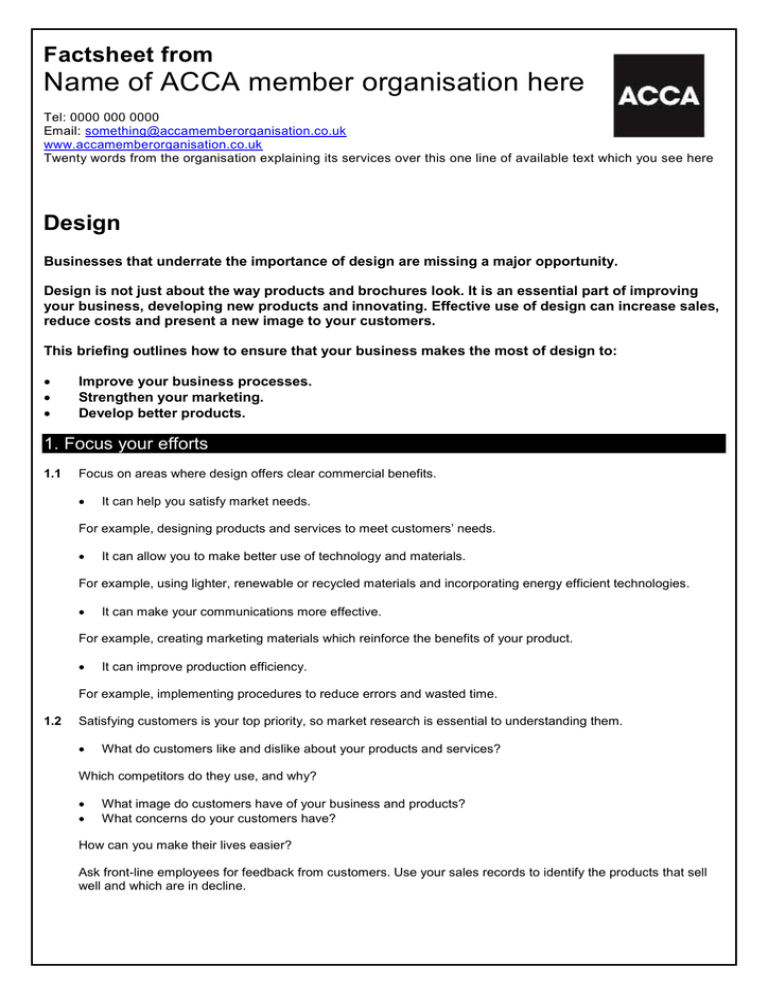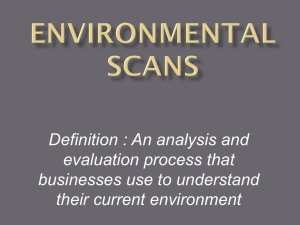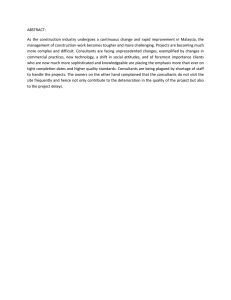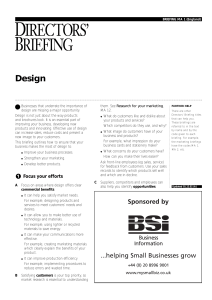
Factsheet from
Name of ACCA member organisation here
Tel: 0000 000 0000
Email: something@accamemberorganisation.co.uk
www.accamemberorganisation.co.uk
Twenty words from the organisation explaining its services over this one line of available text which you see here
Design
Businesses that underrate the importance of design are missing a major opportunity.
Design is not just about the way products and brochures look. It is an essential part of improving
your business, developing new products and innovating. Effective use of design can increase sales,
reduce costs and present a new image to your customers.
This briefing outlines how to ensure that your business makes the most of design to:
Improve your business processes.
Strengthen your marketing.
Develop better products.
1. Focus your efforts
1.1
Focus on areas where design offers clear commercial benefits.
It can help you satisfy market needs.
For example, designing products and services to meet customers’ needs.
It can allow you to make better use of technology and materials.
For example, using lighter, renewable or recycled materials and incorporating energy efficient technologies.
It can make your communications more effective.
For example, creating marketing materials which reinforce the benefits of your product.
It can improve production efficiency.
For example, implementing procedures to reduce errors and wasted time.
1.2
Satisfying customers is your top priority, so market research is essential to understanding them.
What do customers like and dislike about your products and services?
Which competitors do they use, and why?
What image do customers have of your business and products?
What concerns do your customers have?
How can you make their lives easier?
Ask front-line employees for feedback from customers. Use your sales records to identify the products that sell
well and which are in decline.
1.3
Suppliers, competitors and employees can also help you identify opportunities.
What causes your employees problems or wastes their time?
What are the most common mistakes?
What new products and technologies are suppliers offering or aware of?
What would make suppliers deliver faster or offer you better payment terms?
How can you beat the competition?
How do your key performance indicators (eg delivery times, percentage of faulty goods) compare? What are the
key design features of your competitors’ products and services? How do they promote themselves?
Keep up to date with market trends and regulations and standards through trade bodies, publications and
business contacts.
2. Planning
Whether you are designing a complex environment, product or process, or just a simple leaflet, investing in design
minimises the risk of needing to make costly changes later.
Involve any outside help you need right from the start (see 5). A methodical approach will help to guarantee a
successful outcome.
2.1
Assemble a project team (see 4) to manage the design process.
Set specific, quantified objectives.
Set a budget.
Allow for contingencies and for the cost of external consultants.
Set a timetable.
Include any milestones for the project and the target completion date.
Plan how you will monitor and measure progress and expenditure.
2.2
Prepare a design brief (if you are using a design agency, they will do this with you).
The brief should describe your business background.
Who are your customers and what are their needs? What are your strengths and weaknesses?
Your brief should include a clear description of the project. What are your objectives? How will the finished
design be used?
Budgets and timetables should form part of the brief.
The brief should highlight any other constraints on the design.
For example, are there any specific technical or legal requirements?
A clear design brief is essential whether you will be involving outside help or not.
2.3
Turn the brief into a design specification (see 3).
2.4
A design specification is a plan of how to meet your objectives whilst adhering to your budget, timescales
and other constraints.
Make manufacturing and marketing plans an integral part of the design process.
2
How much take-up are you anticipating and how long will it take you to meet demand?
Which components will you make in house and which will you buy in? Will you need to sub-contract any
work?
How can you minimise the cost of components?
Can you use standard components and tools across a range of products rather than more expensive custommade ones?
What production capacity will need to be available, when? What volumes of supplies will you need?
How will this fit in with your (and your suppliers’) existing workflow?
Can you improve your use of technology?
Can you increase the productivity of your production processes?
Are you minimising wasted raw materials and energy usage?
2.5
How will you promote and distribute new products and services?
Will employees need support?
Plan how you will protect your intellectual property.
Protecting your intellectual property can reduce the threat from competition. There are several options:
patent protection for new and innovative products
design registration to protect the shape or appearance of a product
registered trade marks which distinguish your product from the competition
For more information, contact the Intellectual Property Office on 0300 300 2000 or visit www.ipo.gov.uk.
3. The specification
Creating a good design specification is critical to the success of the project. A design consultant can help you avoid
making expensive mistakes during this process (see 5).
Different types of design present different opportunities and problems. Some of the main issues to consider are
outlined below.
3.1
What benefits should the design deliver?
What market needs will products and services satisfy?
How will they be distinguished from competing products and services?
3.2
Who is involved with work processes and what are their requirements?
What are the key features and functions of the design?
What does it do and how does it do it?
What performance levels must it achieve?
How durable must it be?
What will the product’s working life be?
How will the product be constructed?
What materials will it be made from? Can it be recycled?
3
3.3
What does its visual appearance say?
What image are you trying to create?
Are your company image and the image of your products or services consistent?
3.4
What quality standards must you achieve?
3.5
Does the standard of your marketing materials match your corporate image?
Can you design products and production processes to minimise the percentage of faulty goods?
Are there any formal quality standards or regulatory requirements you must meet?
How will the design be tested?
Will you develop a single design or several alternative versions?
How will you choose between designs (eg by testing prototypes with customers)?
Do you need to carry out a technical feasibility study before you go ahead?
Are there any technical problems that you need to overcome?
4. The design team
4.1
Identify who should be in the project team.
4.2
Communicate the brief to everybody involved.
4.3
Hold brainstorming sessions to generate ideas.
Explain how everything fits together.
Give every team member an achievable objective.
Debrief everybody at the end of the project.
4.6
Choose somebody with experience of project management.
Facilitate co-operation.
4.5
Explain to employees how the project will benefit them.
Give one individual overall responsibility for the project.
4.4
Include employees who are going to be affected by the changes.
Include people with specific design skills. If necessary, bring in external consultants.
Include key suppliers and anyone else with an interest in the design.
List all the incremental improvements that have been made as part of the project.
Identify what works better and what still needs improvement.
Hold periodic discussions to continue the process of improvement for both individual designs and your overall
design process.
5. Using outside help
Good designers help you to move quickly from a problem to providing a possible answer.
4
Even if there is no quick solution, involving a designer will clarify what else needs to be done.
5.1
Design advisers at, or referred through, your local business support organisation can help with most aspects of
design.
An initial visit to assess your needs can be followed by specific support and advice.
Design advisers can also help you find suitable design consultants.
5.2
The Design Business Association (020 7251 9229 or www.dba.org.uk) offers a searchable directory on its
website.
5.3
Design consultants can help in their own areas of expertise.
Before taking on a consultant, prepare a brief (see 2.2). Ask selected consultants to give a presentation on what they
can offer, and to provide details of previous projects.
Consultants tend to focus on one area of design.
A good designer will need to fully understand your business and will integrate design advice into your
business planning.
Premises
A.
Design for sales.
B.
Are your premises attractive to customers?
Would corporate clothing be an advantage?
Are products displayed effectively with benefits clearly signposted?
Design for productivity.
What is the workflow from delivery of supplies, through the production process to despatch of finished
goods?
Which employees work together and use the same documents or equipment?
Can you improve health and safety, and the welfare of employees?
Like most design opportunities, effective planning (see 2) and professional help (see 5) will reduce losses and
increase potential.
Brochures
Brochures (and other marketing materials) communicate with your customers. Simplicity and clarity are essential.
How will you make an immediate impact?
This is especially vital if your brochure has to compete with other marketing materials.
Is it easy to understand?
Is the type size and font appropriate for your readership?
Complicated designs and ornate type-faces may look attractive but can be difficult to read.
What message are you trying to get across? Is it put simply?
Focus on one or two key selling points.
What image are you trying to create?
For example, an expensive brochure can be inappropriate for a cheap and cheerful product and vice versa.
5
How will the brochure be used?
Size, weight, durability and flexibility can all be important features.
Your competitors’ marketing material can be a useful source of both good and bad ideas.
A good designer will create material which conveys your company image and values.
Packaging
Well-designed packaging has to take account of a wide range of requirements.
A.
What are the functional requirements?
B.
What are the aesthetic requirements?
C.
How well does the product need to be protected?
Does the product need to be kept fresh?
How will the product be handled and stored?
How will the packaging contribute to the image of the product?
How will the product be displayed?
What are the environmental requirements?
Not only is there an increasing volume of regulation to take into account, but many customers prefer
environmentally responsible suppliers and products.
Are you minimising wasteful packaging?
Can you use packaging materials that can be reclaimed or recycled?
Experts’ quotes
“A designer sets out to enhance the appeal, improve the usability and influence the perception of your product, space
or service, As such, design is integral to marketing and realising your business vision.”
Dan Newman-Turner,
DesignRock Ltd
“Aim for consistent design across your business and product range. For example, creating a series of brochures which
share a common design and artwork saves money. It also looks far more professional than several one-off designs.”
Julia Gosling,
mabox
Expert contributors
Thanks to Dan Newman-Turner (DesignRock Ltd, 0117 956 7971).
Last updated 01.06.11
© BHP Information Solutions 2011. ISSN 1369-1996. All rights reserved. No part of this publication may be reproduced or transmitted without the
written permission of the publisher. This publication is for general guidance only. The publisher, expert contributors and distributor disclaim all liability
for any errors or omissions. Consult your local business support organisation or your professional adviser for help and advice.
6




